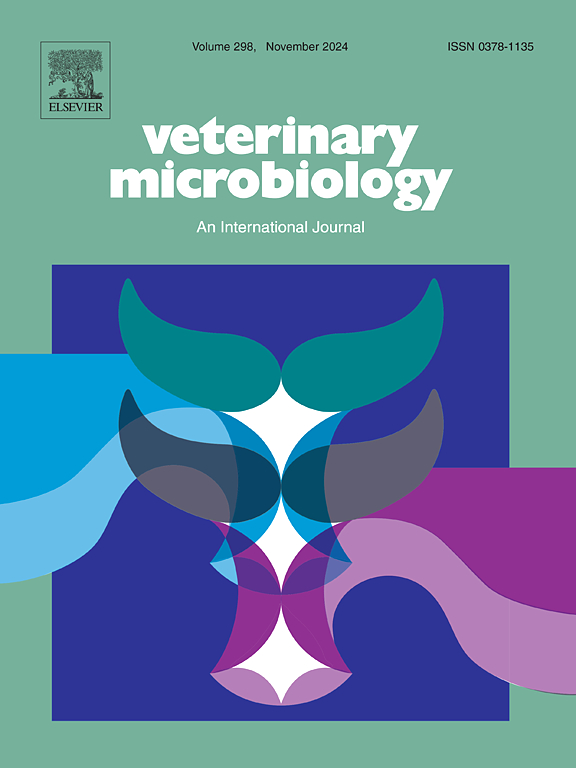溶瘤性禽呼肠孤病毒调控小鼠黑色素瘤细胞诱导自噬的TLR3-IRF3-IFN-γ-JAK-STAT1和TLR3-NF-κB-IFN-γ-JAK-STAT1通路
IF 2.4
2区 农林科学
Q3 MICROBIOLOGY
引用次数: 0
摘要
溶瘤性禽呼肠孤病毒(ARV)是一种能够选择性感染和诱导多种癌细胞系细胞死亡的病毒。本研究通过TLR3-IRF3-IFN-γ-JAK-STAT1和TLR3-NF-κB-IFN-γ-JAK-STAT1通路,探讨ARV在B16-F10小鼠黑色素瘤细胞中激活先天免疫应答的作用。结果表明,ARV的σC蛋白与细胞质中的toll样受体3 (TLR3)相互作用,导致IRF3和NF-κB的核易位以及IFN-γ的上调,定量实时逆转录和聚合酶链反应(qRT-PCR)、酶联免疫吸附试验(ELISA)、近端结扎试验(PLA)和Western blot证实了这一结果。针对TLR3、活化B细胞核因子κB轻链增强子(NF-κB)和干扰素调节因子3 (IRF3)的抑制实验进一步验证了TLR3-IRF3和TLR3-NF-κB通路参与IFN-γ活化。此外,用信号传导和转录激活因子1 (STAT1) shRNA和Janus激酶(JAK)抑制剂处理的细胞发现,ARV通过IFN-γ-JAK-STAT1途径促进细胞自噬。免疫荧光染色和LC3-mCherry转染进一步证实了ARV通过TLR3-IRF3-IFN-γ-JAK-STAT1和TLR3-NF-κB-IFN-γ-JAK-STAT1通路触发自噬的作用。我们的研究结果表明,溶瘤性ARV在小鼠黑色素瘤细胞生命周期中后期诱导自噬和凋亡。这些发现强调了ARV通过激活癌细胞免疫通路作为一种新的溶瘤病毒疗法的潜力。本文章由计算机程序翻译,如有差异,请以英文原文为准。
Oncolytic avian reovirus regulates the TLR3-IRF3-IFN-γ-JAK-STAT1 and TLR3-NF-κB-IFN-γ-JAK-STAT1 pathways inducing autophagy in murine melanoma cells
Oncolytic avian reovirus (ARV) has been identified as a virus capable of selectively infecting and inducing cell death in various cancer cell lines. This study investigates the role of ARV in activating innate immune responses in B16-F10 murine melanoma cells, focusing on the TLR3-IRF3-IFN-γ-JAK-STAT1 and TLR3-NF-κB-IFN-γ-JAK-STAT1 pathways. Our results revealed that the σC protein of ARV interacts with toll-like receptor 3 (TLR3) in the cytoplasm, leading to nuclear translocation of IRF3 and NF-κB as well as the upregulation of IFN-γ, as confirmed by quantitative real-time reverse transcription and polymerase chain reaction (qRT-PCR), enzyme-linked immunosorbent assay (ELISA), proximity ligation assay (PLA), and Western blot. Inhibition assays targeting TLR3, nuclear factor kappa-light-chain-enhancer of activated B cells (NF-κB), and interferon regulatory factor 3 (IRF3) further validated the involvement of the TLR3-IRF3 and TLR3-NF-κB pathways in IFN-γ activation. Additionally, cells treated with signal transducer and activator of transcription 1 (STAT1) shRNA and Janus kinase (JAK) inhibitor revealed that ARV promotes autophagy via the IFN-γ-JAK-STAT1 pathway. Immunofluorescence staining and LC3-mCherry transfection further confirm ARV’s role in triggering autophagy via TLR3-IRF3-IFN-γ-JAK-STAT1 and TLR3-NF-κB-IFN-γ-JAK-STAT1 pathways. Our results revealed that oncolytic ARV induces autophagy and apoptosis in middle to late stages of virus life cycle in murine melanoma cells. These findings highlight the potential of ARV as a novel oncolytic virotherapy through immune pathway activation in cancer cells.
求助全文
通过发布文献求助,成功后即可免费获取论文全文。
去求助
来源期刊

Veterinary microbiology
农林科学-兽医学
CiteScore
5.90
自引率
6.10%
发文量
221
审稿时长
52 days
期刊介绍:
Veterinary Microbiology is concerned with microbial (bacterial, fungal, viral) diseases of domesticated vertebrate animals (livestock, companion animals, fur-bearing animals, game, poultry, fish) that supply food, other useful products or companionship. In addition, Microbial diseases of wild animals living in captivity, or as members of the feral fauna will also be considered if the infections are of interest because of their interrelation with humans (zoonoses) and/or domestic animals. Studies of antimicrobial resistance are also included, provided that the results represent a substantial advance in knowledge. Authors are strongly encouraged to read - prior to submission - the Editorials (''Scope or cope'' and ''Scope or cope II'') published previously in the journal. The Editors reserve the right to suggest submission to another journal for those papers which they feel would be more appropriate for consideration by that journal.
Original research papers of high quality and novelty on aspects of control, host response, molecular biology, pathogenesis, prevention, and treatment of microbial diseases of animals are published. Papers dealing primarily with immunology, epidemiology, molecular biology and antiviral or microbial agents will only be considered if they demonstrate a clear impact on a disease. Papers focusing solely on diagnostic techniques (such as another PCR protocol or ELISA) will not be published - focus should be on a microorganism and not on a particular technique. Papers only reporting microbial sequences, transcriptomics data, or proteomics data will not be considered unless the results represent a substantial advance in knowledge.
Drug trial papers will be considered if they have general application or significance. Papers on the identification of microorganisms will also be considered, but detailed taxonomic studies do not fall within the scope of the journal. Case reports will not be published, unless they have general application or contain novel aspects. Papers of geographically limited interest, which repeat what had been established elsewhere will not be considered. The readership of the journal is global.
 求助内容:
求助内容: 应助结果提醒方式:
应助结果提醒方式:


